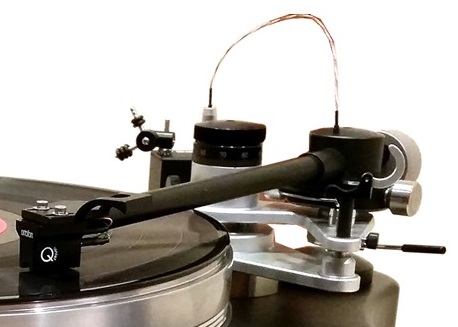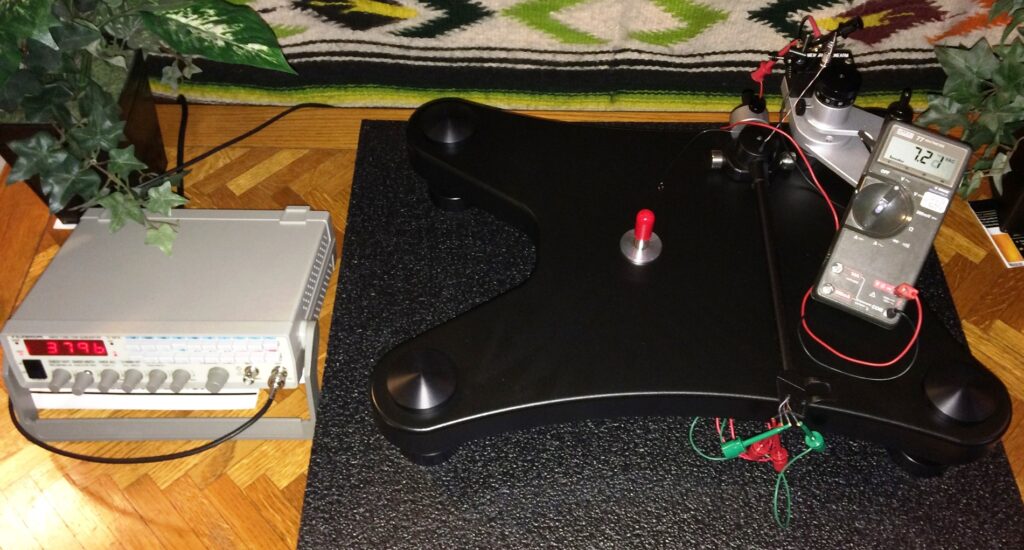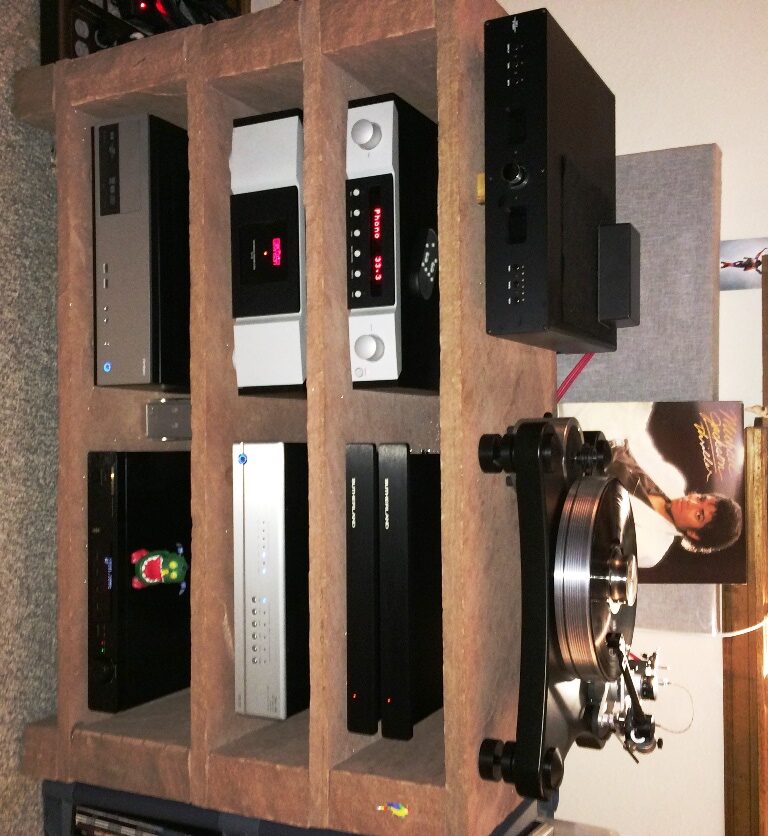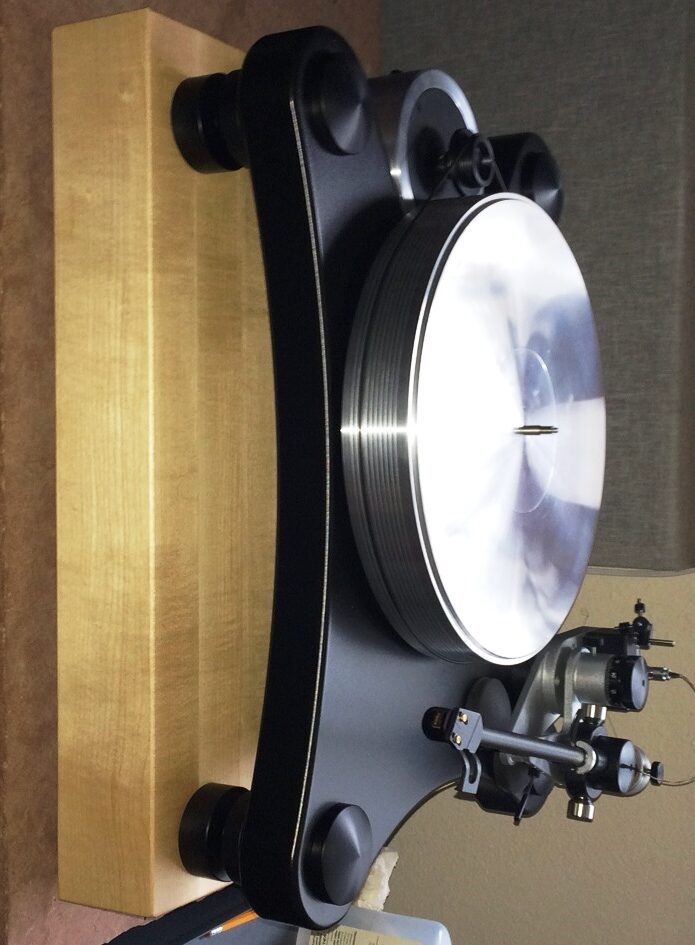Making quick judgments about the sound of a new component is dangerous. Those snap judgments are usually just a comparison to another component and are subject to change as the listener gets to know the new component better over time. For a new component, being definitive is often being silly.
However, there is a valid point to be made with these quickly developed opinions. They avoid the effects of adaptive listening. This is where we develop internal mental filters, not unlike DSP or other wide band processing, that help the brain determine what the sound actually is without being subliminally adjusted to what we expect or want to hear, or not hear. The latter could be called the “Husband Effect”.

But that is exactly how we will be looking at the VPI Prime turntable with its companion JMW 3D printed tonearm today because the week of experience that supports this review follows three years of listening to a Basis 2500 Signature turntable with Vector 4 tonearm. There were quite a few snap judgments upon moving the Miyajima Madake moving coil cartridge from the Basis, list price about $19,000, to the VPI Prime, list price $3,800, and I wanted to share some of them before I adapt too much to the sound of the Prime and lose some degree of objectivity and detachment.
The major components on hand include a Mark Levinson No. 52 preamplifier with its excellent built-in phono preamplifier, Bent Audio Tap-X preamplifier, Sutherland DUO phono preamp, Acoustic Imagery Atsah amplifiers and Magnepan 3.7 loudspeakers with Mye stands.
The Basis 2500 Signature table with Vector 4 tonearm is a very satisfying record player which is able to present huge 3-D soundscapes with outstanding harmonic resolution. It is certainly resolving enough to let one hear minor differences in cartridge loading or VTA, and showcase the musical performances – and differences – of the Miyajima Kansui and wonderful new Madake cartridges. There was no pain associated with long term listening to the Basis turntable or desire to make a change away from it, other than innate curiosity and the feeling of “so many turntables, so little time”. Let’s see how the Prime measures up in this unfair comparison.

I first set the Prime aside and, using a sweep signal generator, let the tonearm wiring break in for about 75 hours at 7 Volts. This equates to 263 hours at 2 Volts line level, or 11.5 years of playing records non-stop.
Set up proceeded smoothly. The included flash drive with set up videos and documentation augments the printed user manual. There is a cartridge alignment fixture to set overhang and even a nice digital stylus force gauge to help set VTF. The feet allow quite a lot of adjustment for leveling the table. You will need a bubble level. I am not using the included rubber mat, instead placing the LP directly on the bare aluminum platter. I continue to use a Stillpoints LPI record weight with the Prime since it was also used with the Basis 2500 Signature. One less variable. The nicely made VPI record clamp that is included will be evaluated later.
The first impressions after lowering the stylus on a record were positive; very positive, in fact. The sound is very dynamic with a lively, slightly forward temperament. The bass is powerful and extends very deeply with excellent resolution. These impressions happened in the first few minutes of listening and persisted throughout this short “get-acquainted” period.
Compared to my well-established aural memory of the Basis, the VPI’s overall soundstage volume is more compact, although image placement is excellent. Left-to-right imaging is a bit better than the Basis. The sense of an individual singer being present in 3 dimensions is a little less tangible. The major difference between these two tables, besides the price (the Vector 4 tonearm alone costs about a thousand dollars more than the Prime and 3D tonearm combined) is a small reduction in low level resolution. This most likely contributes to these impressions of the soundstage.

I have an untested hypothesis for why very low level resolution seems comparatively less, and it is all my fault. The rack weighs over 750 pounds and is made from sandstone from a quarry near Estes Park, Colorado. It rings. The very effective Resonance Annihilator feet on the Basis table make it almost completely immune to the vibrations of the rack. The Prime’s feet are very good at isolating these structural vibrations in the lateral plane, but vertical vibrations are conducted right up the feet to the MDF plinth. Tap on the platter and very little of that impulse reaches the cartridge, but tap on the shelf or plinth and you’ll hear it. For the Basis table, tapping on the plinth is audible through the cartridge, too, although at a lower level.
VPI recommends placing the Prime on a 3 inch thick maple support, and one measuring 21 x 16 x 3 inches is on order. I am certain that this will help by reducing structure-borne vibrations that obscure micro detail in LP recordings.
Large scale macro dynamics and smaller micro dynamics are outstanding, no question about it. From the minute tapping on a cymbal to the explosion of a big bass drum, this turntable lives to communicate the power and urgency of every instrument.
The overall sound, octave to octave, is very linear with no highlighting of any small frequency range. Notes flow up and down the scale properly, and in correct relative proportion to other frequency ranges. The Prime does not sound warm or cool, just neutral with a touch of liveliness that does not include any hint of harshness or overreaching brightness.
Speed stability is very good at my location and I do not see a need to add VPI’s SDS motor speed controller or another similar device. After all, at the true bargain price of the Prime and 3D tonearm, it seems counterproductive to add expensive accessories. However, there are some opportunities for after-market upgrades.
I look forward to listening to the VPI Prime with JMW 3D tonearm each evening. The differences between it and a five times more expensive analog rig are apparent in degree, but not serious enough to feel a desire to reconnect the older table. I think there might be some adaptive listening taking hold because the sound seems to get better every evening. Something is breaking in here.
MARCH, 2015 UPDATE
Let’s start this update with the question of using the entire Prime package, including the VPI record clamp. Some readers expressed dismay, and even some anger, that the preliminary review above used the Stillpoints record weight instead of the VPI clamp. The Stillpoints clamp is a master at increasing the apparent size of the sound stage, which is the width, depth and height of the image of the musicians and the stage upon which they perform. Additionally, the LPI expands the entire performance space, allowing your room to sound like a much larger space when appropriate to the recording.
Replacing the LPI weight with the standard VPI record clamp has a predictable effect, decreasing the overall volume of the performance space. The VPI clamp is a good performer and is better than using no clamp. It is roughtly equilavent in overall performance to the Basis clamp. The VPI record clamp is a worthwhile device to employ regularly.
Now, after having roughly ten times the listening experience with the Prime now as for the introductory comments above, I can offer few significant changes or insights. One cartridge distributor suggested that the 3D printed tonearm is overdamped. I think it sounds excellent. The yawing of the tonearm when using the finger lift is bothersome, but can be minimized if one uses the cuing lever to lower and raise the tonearm.

The 3″ maple platform arrived and was installed immediately. (Who can wait to add system tweeks???) It does indeed reduce vibrations and impulses from the supporting sandstone shelf. Although the audible difference when the Prime’s plinth is tapped between the original setup with the Prime on the stone shelf and now, with the Prime sitting on the maple platform, is minimal. The maple platform contributes a very slight sweetening or less edgy sound to the upper frequencies.
Compared to the Prime, the Basis 2500 Signature turntable offers a warmer overall tonal balance with a bit more low level information. Harmonic trails last just a little longer. Singers have a bit more depth and warmth. These are often the kinds of differences we hear with different interconnects or cartridges, but using the same interconnects and cartridge on both turntables suggests that the Basis is more resolving, as it should be considering the difference in cost.
This is a very high performance turntable package offered at a very competitive price. It has been 100% reliable and seems, so far at least, to hold its settings without further adjustment. The dynamic presentation, powerful bass and extended, clear treble produce very enjoyable listening sessions with remarkable see-through connection to the music. Notice that I did not write “at this price”. The VPI Prime is a turntable that looks great, has some very effective technology, and is a well-executed design that simply sounds very good. Very good, indeed.
Overall Rating: 8.5 LPs
A big “thank you” to Bob at Bob’s Devices for his kind assistance with this review. Please see the 10 Audio reviews of the Bob’s Devices CineMag 3440A Step Up Transformers and the CineMag 1131 Step Up Transformers.
